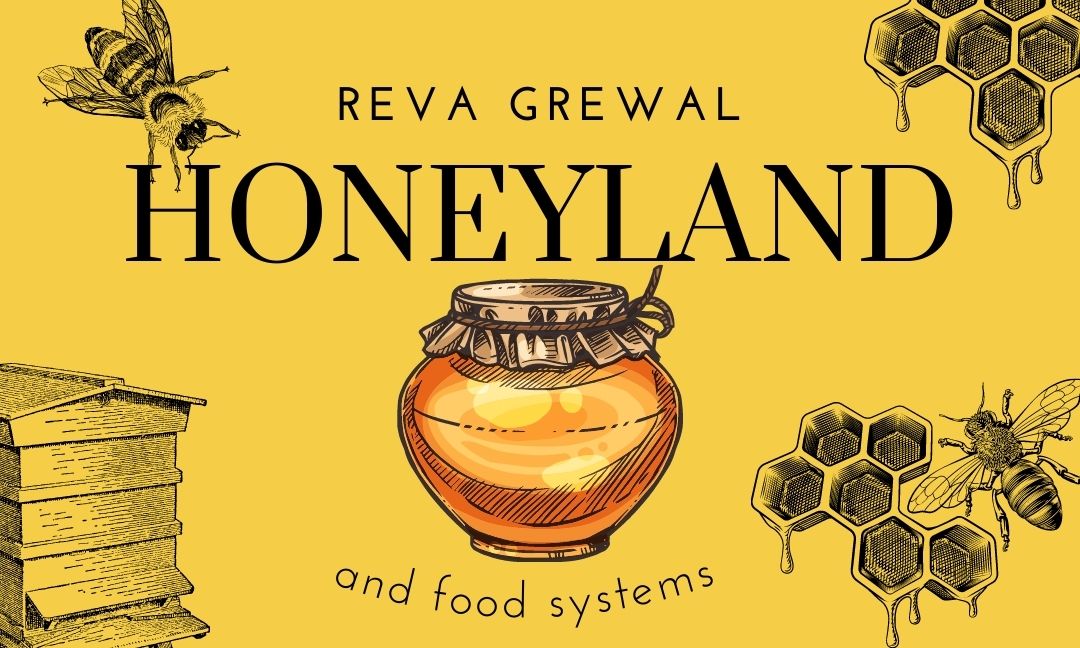Author: Reva Grewal
Editor: Emily Usprich-Couture
Graphic Designer: Emily Sheng
Publisher: Jumana Ismail
Food Systems describe a vital part of everyone’s daily lives. It stands to reason that its involvement would be featured in media. For today’s post, Honeyland will be examined for its description of the production and distribution of honey for one producer in rural Macedonia. Parallels will be drawn to events occurring in Ontario, as we can find that specific instances can lead to greater connections. While the film broaches beyond ecological concepts, such as concepts of love and family, an ecological lens will be taken for the purpose of this analysis.
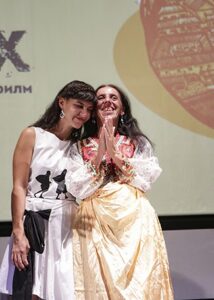
The Sams do not listen, leading to the destruction of her hive (Brody).
Honeyland for those of you who may be unfamiliar is a documentary that follows a beekeeper in rural Northern Macedonia, named Hatidze Muratova. The directors of this film are Ljubomir Stefanov and Tamara Kotevska (Scott). Hatidze resides solely with her mother and uses old methods of beekeeping. Her mantra is: “Half for me and half for you”, which in this context means she leaves half the honey for the bees and uses half of the honey to sell for income (Kovacevic). What’s especially prominent throughout this film is the bond that Hatidze shares with the bees she tends to. The care and appreciation she shares is made abundantly clear every time she interacts with the bees. The main conflict in this documentary is when the Sam family arrives. Accompanying their arrival is a herd of cows, children, and a drive to maximize profit. The family inquires about the income Hatidze receives from beekeeping, and the Sams seeing it as profitable, decide to start their own hive. Hatidze kindly provides pointers on how to create a healthy hive, and cautions them about leaving half the honey so the bees do not attack her hive for their honey. Image Courtesy: (Kotevska)
destruction of her hive (Brody).
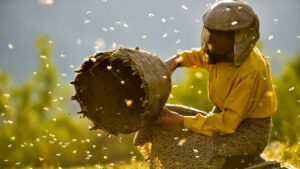
Image source: (NEON)
Now that context has been provided, I would like to look at the production and distribution of honey. In this film, the amount of equipment and machinery used is practically non-existent. Hatidze does not use equipment when handling the bees but still remains untouched when harvesting honey. The only sort of equipment she uses is a bee net around her head and places the honeycombs into a sack. The hive itself was transplanted into a natural stone wall (Scott). In terms of distribution, it is all Hatidze. She makes the journey to Skopje to sell her honey, on her own. She is the benefactor of her efforts, and this system consists of her efforts only. She is the supplier and distributor. In contrast, the Sam family similarly harvests and distributes honey the way that Hatidze does. However, the sustainability aspect is non-existent. Hussein Sam, the father, is not a rich corporate man but quite the opposite (Powers). The issue is, the environmental impacts are lost upon him.
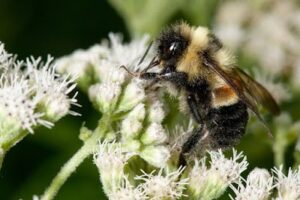 How does this correlate to areas in Ontario? The most direct comparison is the loss of bees in Ontario due to various causes. In 2009, the rusty patched bumble bee who lived abundantly in Ontario was essentially considered extinct (Alamenciak). Honey Bees that are not native to Ontario also deal with struggles in Ontario, with the typical culprits being climate change, habitat loss, and biodiversity issues. The non-native bees are imported from South America. These bees are in part responsible for the deaths of wild Canadian Bees, as they carry new infections (Hristova). This Rusty Patched Bumble Bee (Holm) parallels Honeyland, wherein the Sams can be connected to the new bees invading the old bees’ (Hatidze’s) territory.
How does this correlate to areas in Ontario? The most direct comparison is the loss of bees in Ontario due to various causes. In 2009, the rusty patched bumble bee who lived abundantly in Ontario was essentially considered extinct (Alamenciak). Honey Bees that are not native to Ontario also deal with struggles in Ontario, with the typical culprits being climate change, habitat loss, and biodiversity issues. The non-native bees are imported from South America. These bees are in part responsible for the deaths of wild Canadian Bees, as they carry new infections (Hristova). This Rusty Patched Bumble Bee (Holm) parallels Honeyland, wherein the Sams can be connected to the new bees invading the old bees’ (Hatidze’s) territory.
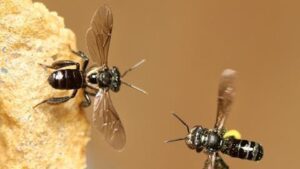 To be more general, Honeyland teaches us about the dangers of unsustainable consumption and the production of agriculture. Small-scale sustainable farms in Ontario struggle with competing with big-chain farms that sell to large grocery stores. These small-scale farms (make up over 1.5% of farmland in Canada), produce organic produce, meaning pesticides and other harmful chemicals were not utilized. Stingless Bee (Shutterstock)
To be more general, Honeyland teaches us about the dangers of unsustainable consumption and the production of agriculture. Small-scale sustainable farms in Ontario struggle with competing with big-chain farms that sell to large grocery stores. These small-scale farms (make up over 1.5% of farmland in Canada), produce organic produce, meaning pesticides and other harmful chemicals were not utilized. Stingless Bee (Shutterstock)
Furthermore, the energy utilized is renewable, more money is required to support this methodology, and biodynamic techniques are incorporated. However, the large-scale chain farms use such chemicals to grow their produce bigger, and faster, to the detriment of the environment. Therefore, their farming would not be considered sustainable as the land they inhabit may become unusable if it is continually damaged chemically. Hatidze in this case would represent the small-scale farmer. Whilst Hussein Sam was not a large-scale farmer, he still farmed unsustainably similarly to how many do. The biggest issue with this is that small-scale farmers remain largely unsupported by the dominant market (Kuitenbrouwer).
To conclude, Honeyland is a fantastic documentary that teaches us about many concepts. One such concept that affects the world, is that of sustainable food systems, which seems to be an issue as it stands. Small-scale farmers are not properly supported, but improvements are occurring (the Community Share Agriculture program). Despite its simplicity, the statement, “Half for me and half for you” should not be taken lightly. If you feel compelled to change consumer habits, the following are a couple of ways to support sustainable farming. Thanks for reading!
Some ways to support sustainable farming:
- Purchase local foods
- Buy what is in season from local markets
- Purchase organic and fairtrade foods, budget permitting
- Advocacy
The following link goes more in-depth for these ideas:
https://www.goingzerowaste.com/blog/7-tips-for-eco-friendly-grocery-shopping/
Works Cited
Alamenciak, Tim. “Endangered Ontario: The Mystery of the Rusty-Patched Bumblebee.” TVO.org, 24 July 2017,
http://www.tvo.org/article/endangered-ontario-the-mystery-of-the-rusty-patched-bumblebee.
Brody, Richard. “‘Honeyland,’ Reviewed: A Gripping, Frustrating Documentary about a Beekeeper’s Fragile Isolation.” The New Yorker, 1 Aug. 2019,
Holm, Heather. “Rusty-Patched Bumblebee.” University of Minnesota Extension, 10 Apr. 2019,
http://blog-yard-garden-news.extension.umn.edu/2019/04/will-rusty-patched-bumble-bee-become.html.
Hristova, Bobby. “‘It’s Almost Too Late:’ Canada Protects Honey Bees but Native Bee Species Are Becoming Endangered.” Nationalpost, National Post, 31 July 2019,
Kotevska, Tamara. “Hatidže Muratova Was at the Center of the Film. Co-Director Tamara Kotevska Says That the Attention given to Hatidže and the Film Shows That the ‘World Is Tired of False Super Heroes.’” Kosove 2.0,
https://kosovotwopointzero.com/en/from-honeyland-to-the-oscars/.Accessed 21 Dec. 2021.
Kovacevic, Tamara. “Honeyland: Life Lessons from Europe’s Last Wild Beekeeper.” BBC News, 9 Feb. 2020, http://www.bbc.com/news/entertainment-arts-51401315.
Kuitenbrouwer, Kathryn. The Struggles of Sustainable Farming | the Walrus. The Walrus, 23 July 2020, thewalrus.ca/the-struggles-of-sustainable-farming/.
NEON. “Haditze Muratova Harvesting Honey.” BBC News,
http://www.bbc.com/news/entertainment-arts-51401315. Accessed 21 Dec. 2021.
Powers, John. “The Beekeeper of ‘Honeyland’ Knows All Too Well: Respect Nature, or Get Stung.” NPR, 12 Aug. 2019,
Scott, A. O. “‘Honeyland’ Review: The Sting and the Sweetness.” The New York Times, 25 July 2019,
http://www.nytimes.com/2019/07/25/movies/honeyland-review.html.
Shutterstock. “Stingless Bee.” ChemistryWorld,
www.chemistryworld.com/news/rare-trehalulose-sugar-found-in-stingless-bees-honey/4012235.article. Accessed 13 Jan. 2022.

